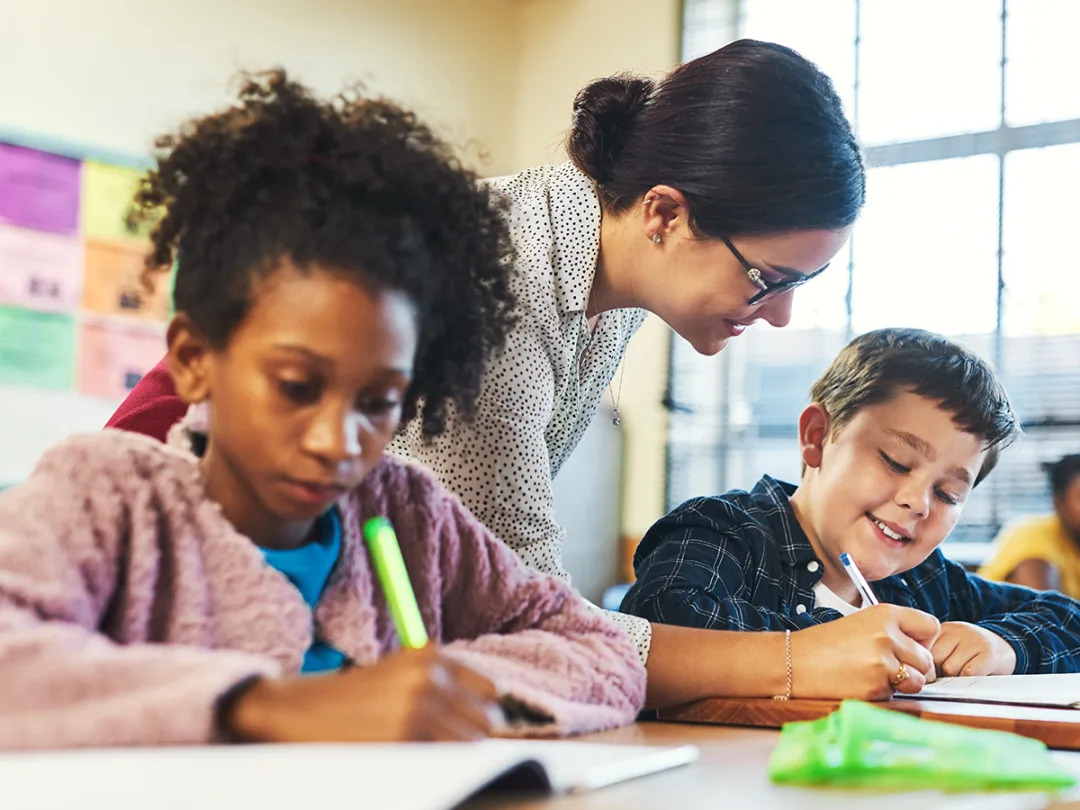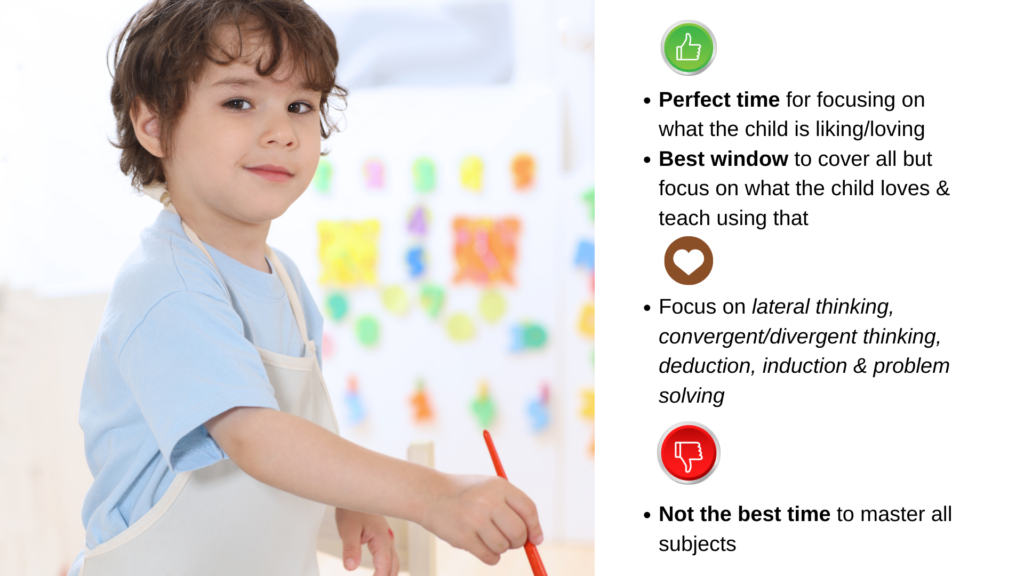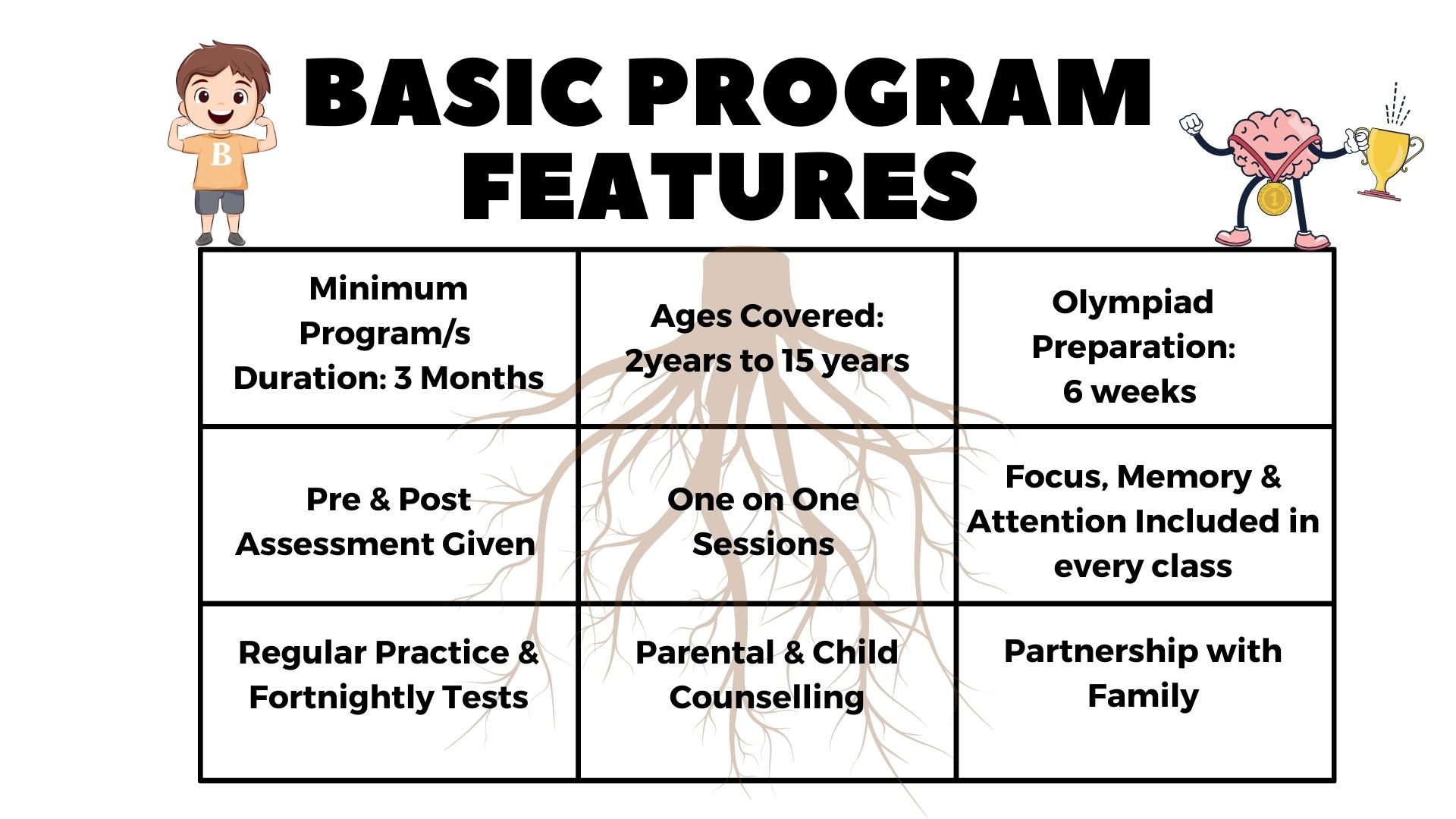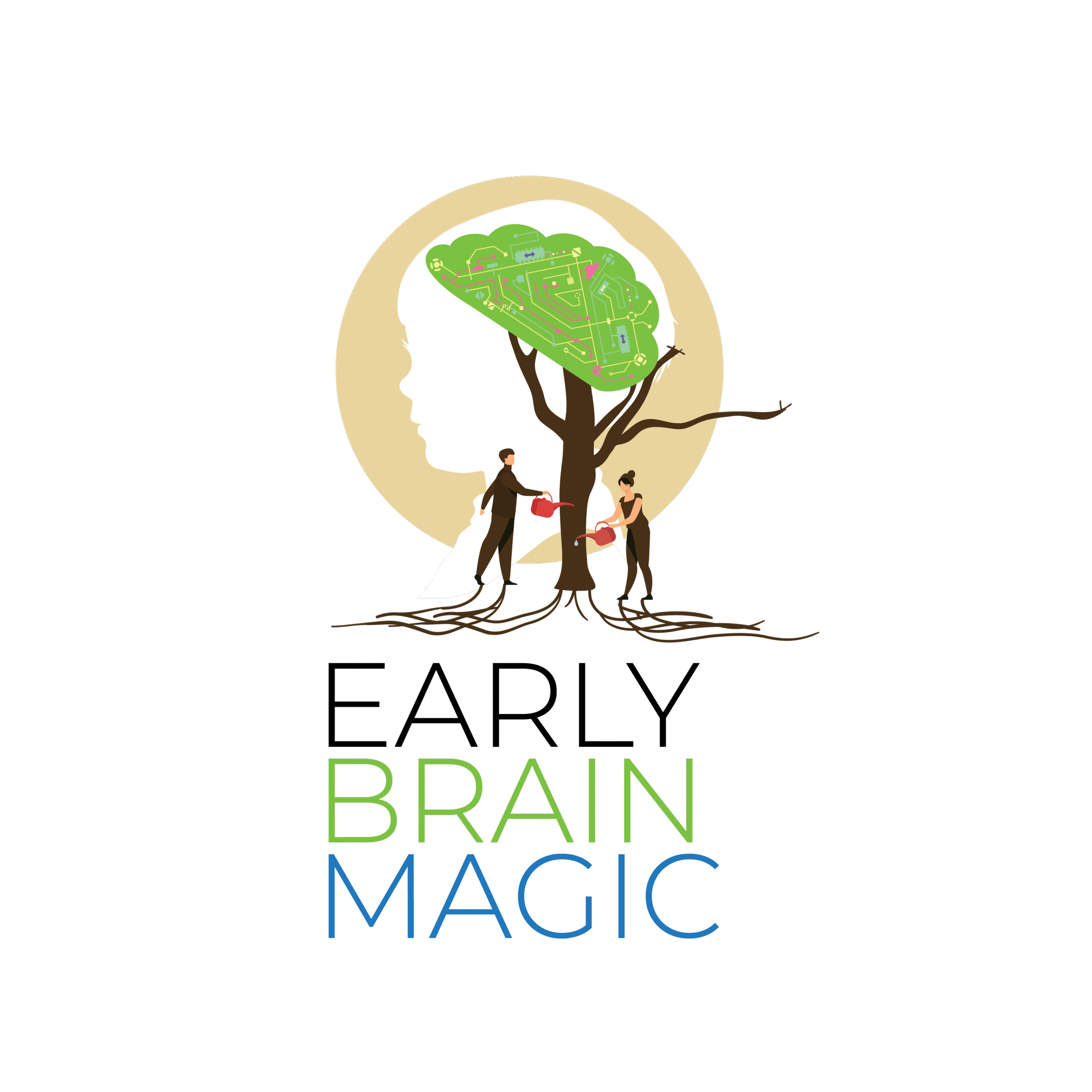BELIEF.TECHNIQUE.MAGIC..
We're Your Most Trusted & Productive Learning Expert
Kids are learning machines.
Our expertise with 100% clear concepts & emotional health helps the child grow.
Super premium program designed for your child :
9820199947


"Learning without clarity & without emotions is out" - Nidhi Panwar
What all age groups we work with ?






How Early Brain Magic Works With Ages From 1-15 Years

Who do we work with?
We work with Children, Parents, Schools & Academic Professionals


Creativity, Problem Solving and Calmness will decide who moves forward. All those who will focus only on marks and the laurels will not be happy. Physical and Mental Health has never been more closely intertwined.

Founder of Early Brain Magic
Story Time
Early Brain Magic Success Stories


Features

Why us

EBM Subjects
Designed to help children realize their potential
Parent Q&A Corner
Child Behaviour & Learning Behaviour
Q&A
Physical & Mental Health
1. Why are eye problems common in children these days?
Eye problems are occurring in children as young as 3 years. Like adults, older children are also going through Digital Eye Strain. This includes looking at the screen for a long time, watching the screen at a close distance, not blinking while looking at the screen, screen being positioned at a downward angle and then not getting enough sleep. This leads to the tear film of the eye getting impacted and the eye drying out – dry eyes will hamper vision. The eyes get tired and fatigued with the glare of the screen and this can have an impact on the retina. This problem is further intensified with children then finishing study time and again using their eyes. In most cases, they would not have an afternoon nap.
2. What are the Signs to be noted by parents?
Some of the common complaints by children that parents should note are : frequent rubbing , continuous Itching, redness in eyes , watery eyes or dried eyes, frequent Squinting and headache. Also Regular Complaints of incomplete class notes , holding books closely while reading, watching tv closely and using phone closely should be noted.
3. Does eye problem have any direct impact on a child’s mental well being ?
While the research related to this is not direct, we believe any physical differentiation will lead to some belief-formation by the child or it could also lead to a different social experience. For example, Weak eyesight causes inability to see and understand the topics written on blackboard which affect the academic performance of the child which results in low self confidence and self doubt. Children might also miss out on some games or sports, due to chances of being hurt or in typical cases they may be ridiculed by other children for wearing spectacles. The style of spectacle also becomes a point as kids do compare the kind of spectacles they are wearing. Professional consultation is important to know about the intensity of the problem and the possible solutions.
4. Why do children refrain from eye checkups ?
Unawareness about the procedure of eye examination, children are afraid of doctors and injection. Young children might struggle to express vision issues verbally. Wearing glasses can sometimes be associated with stigma and teasing by peers and calling with funny names. The image of a hospital environment with patients and medical staff all around contributes to fear and discomfort to the child. Children may associate eye examination with being ill and addition to serious health concerns.
5. What are some tips for healthy eyes?
Digital eye strain is a temporary feature however this is the first generation of kids to be exposed to it. It can be avoided by :
- Taking breaks and limiting usage of TV, mobile, laptops and other gadgets.
- Reading textbook instead of e-books
- Sitting in proper lighting while reading
- Playing outdoor games
- Regular eye checkup
- 8 hours of sleep
6. How Digital Eye Strain can be managed by parents?
Parents can help manage digital eye strain in their children by implementing the following strategies:
- Educating your child about it
- Talking to teachers as aa parental community
- HAVING CLEAR NO-GO AREAS LIKE 6 feet of distance needs to be maintained from the TV
- Putting a simple analog alarm clock so that the time limit beep is there
- Promote proper posture
- Use blue light filters
1.Why should you do body-mind exercises during the day?
Engaging children in random daytime body exercises serves a dual purpose of ensuring they stay active and have fun simultaneously. These exercises contribute to:
- Build focus by requiring them to pay attention to specific movements and instructions.
- Enhance coordination as different body parts are involved.
- Boost reflexes by encouraging quick responses.
- The instructions provided during these exercises foster a habit of adhering to instructions, an essential skill for various aspects of life.
Overall, it’s a playful way to promote both physical and cognitive development in children, making exercise an enjoyable part of their routine.
2. Give ten body mind exercises for cognitive functions
- Table Tennis Challenge: Hit the ball 50 times without a drop.
- Ball Balance: Balance the ball on the racket and place it on the floor, then Lift it without dropping.
- Stone Tower: Gather some stones from the garden and make a tower.
- Hula Hoop Fun: Swirled the hula hoop for a minute without letting it drop.
- Balloon Volleyball: Play volleyball with a balloon, trying to keep it in the air as long as possible.
- Ball Toss: Throw ball into a basket from various distances, aiming for accuracy.
- Memory Game: Lay out random items, memorize their positions, and then rearrange them correctly.
- Balancing Act: Walk along a straight line, ensuring perfect balance without stepping off.
- Paper Plane Precision: Throw a paper plane, aiming for a target.
- Musical Statues: Freeze when the music stops, and resume moving when it starts again.
3. Give eight body relaxing fun exercises
- Jumping Jacks: Start with 2 sets of 20 jumping jacks to get the blood flowing.
- Toe Touches: Reach down to touch toes, gently stretching the back and legs.
- Arm Circles: Rotate arms forward and backward for 1 minute each.
- Knee Hugs: Bring each knee up to the chest in a gentle hug, alternating legs.
- High Knees: Lift knees up towards the chest while jogging in place for 1 minute.
- Neck Rolls: Slowly roll the neck clockwise and then counter-clockwise to release tension.
- Animal Yoga: Introduce yoga poses named after animals – downward dog, cobra, butterfly.
- Simon Says Stretch: Play a stretching version of Simon Says to make it interactive.
1. What is posture and specify which body parts it includes?
Posture is how a person sits, stands, or walks. It involves body balancing, head, shoulder, spine, hips, knees and ankles.
2. What are the Signs that indicate poor posture in children?
- Change in walk like walking speed and bodily movements
- Rounded shoulders: Shoulders hunched forward instead of being relaxed
- Arching back: Visible curvature in spinal cord
- Impaired breathing: Poor posture can restrict lung capacity, leading to shallow breathing
- Headache: Poor posture may be to staring in neck causing chronic headaches
3. How to encourage good Posture habits in children at home?
- Set an example- Children learn through observation, make sure that you have good posture
- Use comfortable seating- Choose chairs which promote good posture
- Encourage breaks-Encourage timely breaks and avoid long seating in one go.
- Physical activities- Engage in physical and outdoor activities together and do light exercises according to the child’s capacity.
4. Is there any direct connection between poor posture and brain activities?
Yes, there is a connection between poor posture and brain activities as posture can influence cognitive and emotional functioning and well-being. Some key points which explains the same are
- Blood Flow- Poor posture can restrict blood flow in the body hence the oxygen level of the body also decreases, which results in poor memory and inattention.
- Muscle tension and discomfort- Poor posture can result in strain in the body, this why you have heard from youth children complaining about body pain.
- Cognitive performance- Poor posture may be associated with decreased alertness and develops the feeling of lethargic.
- Emotional- Poor posture impacts the emotional state of children like sadness and irritability.
- Psychological factors- Poor posture negatively impacts a child’s self esteem and self confidence
5. How can posture be an indicator of mental health?
The way we carry ourselves reflects our mental health and well-being. Imagine someone feeling confident, they stand tall, shoulders back. Stress or low mood might lead to slouching and a downwarded head. So by improving our posture, we are not just taking care of our body, we give a boost to our mental health and well-being.
6. What are some areas where people have good posture?
- Body builder
- Yoga
- Athletes
- Dancers
- Public speakers
- Modeling and acting
7. What are some fun activities that promote good posture?
- Balancing a book on head- Place a book on children’s heads to ask them to balance it as long as they can.
- Wall Angles- Stand against the wall with your hands up so that the back, head and hips touch the wall.
- Chin tuck- While standing or sitting ask your child to tuck your chin towards their chest without tilting their head.
- Heel raise- Ask your child to try to stand with their heel lifted and stretch the body upwards.
- Animal walks- Try fun animal walks with your children like frog jump, bunny hop, or crawling.
- Balancing games- Games like running with one leg or balancing on one leg.
- Bubble Popping- Form bubbles and ask your child to burst them all.
8. How is posture different from posturing?
Posture generally refers to the body position and the way a person sits, stands or walks. While posturing is referred to as behavior or speech intended to impress and attract attention.
Technology
1. What is self and regulation?
“Self” in psychology refers to your sense of identity, like how you perceive yourself, your body, and your belief systems. Now, “regulation” comes into play when we talk about managing or controlling certain aspects of ourselves. Imagine you’re the captain of your own ship. Your “self” is like your ship, and it’s made up of things like how you see yourself, your body, and what you believe in. Now, “regulation” is like being a smart captain. It’s how you steer your ship through the ups and downs of feelings and thoughts.
2. What is self regulation ?
Self-regulation is like being the boss of your feelings and actions. It’s when you decide how to handle being happy, mad, or anything in between. Imagine you have a superhero remote control for yourself – that’s self-regulation, making sure you feel just right.
3. Which behaviors should be self regulated ?
Self-regulation refers to managing and controlling one’s thoughts, emotions, and behaviors. Here are some specific behaviors that could be self regulated.
● Impulse Control: Before doing something quickly, take a moment to decide if it’s a good
thing or not
● Goal Setting: It is like making a plan for things you want to do to achieve your goals.
● Stress Management: Finding ways to feel less worried.
● Cognitive Flexibility: Adjusting your thinking and actions. It’s like being adaptable in decision-making and problem-solving.
● Screen Time: Managing how much time to spend on screens, ensuring a healthy balance with other activities.
● Homework and Study Habits: Regulating study time, creating a routine that works for you.
● Respecting Others: It is important to be mindful of others’ feelings and opinions, and be empathetic and kind.
● Works and Responsibilities: Self-regulate your responsibilities, like keeping your room tidy or completing assigned works.
● Healthy Eating Habits: Make balanced food choices.
● Bedtime Routine: Establish a consistent bedtime routine, promoting good sleep habits for overall well-being.
4. Which behaviors are appropriate to be regulated by external guidance or authority ?
It’s entirely reasonable for individuals to seek guidance from others in various aspects of life. Whether it’s maintaining a consistent meal schedule, asking for help to wake up early, coordinating events, managing studies, adhering to safety rules, navigating technology use, understanding social interactions, or making health-conscious choices, external input can provide valuable insights. Listening to advice from people you trust helps you grow. It develops a sense of support and shared responsibility.
5. Does self regulation mean not seeking help?
No, self-regulation doesn’t mean avoiding help. It means managing your actions and feelings, but it’s perfectly fine to seek help when needed. Seeking help when needed is a smart part of handling things, like asking a friend for advice or talking to someone you trust. It’s about finding the right balance between managing things on your own and reaching out for support when necessary.
6. How to develop self regulation for screen time in children?
● Set Clear Expectations: Clearly communicate screen time rules. Tell them what is allowed and when, develop a sense of structure and predictability.
● Use a Visual Schedule: Create a visual schedule displaying designated screen time and non-screen time periods. Visual cues help children grasp the concept of time and when other activities are planned.
● Involve Children in Rule Setting: Include children in the process of setting screen time limits and rules. Involving children in decision-making encourages responsibility and helps them understand the reasons behind the rules, promoting self-regulation.
● Implement a Reward System: Positive reinforcement can motivate children to self-regulate by associating responsible screen use with rewards such as additional playtime or special activities.
● Use Timers and Alarms: It is easier for them to regulate their screen time independently.
● Create Screen-Free Zone: Designate certain areas, like bedrooms or dining areas, as screen-free zones.
● Model Healthy Behaviour: Demonstrate healthy screen habits by limiting your own screen time. Children often imitate parental behavior. Modeling responsible screen use sets a positive example and reinforces the importance of balance.
● Encourage Non-Screen Activities: Engaging in alternative activities like walking in the park, or playing badminton together could be a better idea.
● Gradual Transition to Screen Time: Avoid sudden changes by allowing a smooth transition. For example, use a “five-minute warning” before ending screen time to help children prepare mentally
1. What are the various forms of technology available for children?
● Audio- Podcasts, music streaming, audiobooks, and radio broadcasts.
● Video- Television, Over-The-Top (OTT) platforms (e.g., Netflix, Prime video),
video-sharing platforms (e.g., YouTube) and video conferencing tools (e.g., Zoom).
● Tactile- Interactive devices such as touchscreens (e.g., smartphones, tablets) and
gaming consoles (e.g., Xbox, PlayStation)
● Verbal- Voice-activated assistants like Amazon Alexa and Google Assistant, as well as
speech recognition software such as Siri on Apple devices.
2. How to explain ‘BALANCE IN TECHNOLOGY’ to children?
Imagine, if you eat too much toffee all the time, your tummy might not feel great, right? or if we only have sunny days and no nights, we’d miss out on stargazing and cozy bedtime stories, right? Similarly, if we always play games or watch videos without break, our brains might feel a bit tired. Just like we need a balance between sweet and savory, we also need a balance between time with technology and without. And, don’t forget, a good night’s sleep helps our brains and bodies recharge for more exciting adventures. So, let’s make sure we have a mix of activities. It’s like having a mix of your favorite chocolates – makes everything more exciting and enjoyable.
3. How can parents strike a balance between allowing their children to benefit from technology
and ensuring they don’t spend too much time on screens?
To maintain a balance in children’s screen time, consider three key factors:
● when they watch (avoid before bedtime and during meals)
● what they watch (ensure age-appropriate content)
● how they watch (maintain a proper distance, control lighting and angles).
4. In what ways can technology be used to enhance educational experiences for children?
Imagine interactive storybooks with animations or educational apps like ABC Mouse, Toondemy, and Kutuki. These tools turn learning into a playful experience. Additionally, platforms like YouTube Kids offer educational content tailored for children. Brain games, both online and offline, help develop critical thinking skills.
5. How can parents participate with their children?
Picture the laughter during a board game night or the joy of watching a favorite movie as a family. Creating your own stories or going on a quest in a family-friendly video game. Fun educational apps like ABC Mouse or exploring interactive adventures in games such as “Toondemy” together can be thrilling. Engaging in these activities not only creates unforgettable moments but also strengthens the bond between family members.
1. In what ways can technology be utilized to promote positive learning experiences for children
without negatively impacting their well-being ?
● Interactive E-books: These books are more appealing than the traditional textbooks
because of animation and sound effects used.
● Educational Applications: Applications for children like ABC mouse, Toondemy, Kutuki
help children learn in a fun way.
● Youtube kids: The app is made specifically for children where the content and
information help them learn.
● Brain games: Games help develop critical thinking in children, these games could be
online or offline.
2. How do screens and phones impact cognitive functions in children?
● Attention- Have you ever asked your child what they just watched, but they could not recall? This is because fast consumption of information in formats like YouTube shorts affect children’s attention span.
● Memory- Do you remember contact numbers of your relatives? Same goes for children. First, they have an overload of information to process. Second, they don’t necessarily need to remember them as they have options to save everything online.
● Decision making- The children these days need social validation as they aren’t confident on their own. Online solutions are available for almost every problem so they do not have to think of a solution which limits their decision making ability.
3. How do LED screens change the brain and how to use it positively?
LED screens emit blue light, affecting the brain’s melatonin production, which can disrupt sleep. To use screens positively, limit use before bedtime, apply blue light filters, and encourage daytime use for learning and productive activities.
4. How do families contribute to make sure that children do not get addicted to technology?
Family can use fun and interactive ways to get children involved in activities that do not involve the use of technology by the following things:
● No Tech Day: Decide a day and take a break from the digital world. Appreciate the importance of togetherness
● Games night: Engaging in board games encourage cognitive development, strategic thinking, social interaction and a sense of belonging.
● Adventure day: Try to go on some adventure on holidays like hiking, camping or simply a walk in a nearby park. Outdoor activities reduce stress and promote emotional well-being.
● Craft day: Participating in creative activities boost self esteem. It encourages a sense of accomplishment.
● Cooking challenges: Cooking involves planning and following instructions enhances attention. Just be very careful so that they do not hurt themselves.
5. Share examples of positive reinforcement in the context of smartphone use & its impact on behavior
When a reward is attached with a behavior it is positive . When a punishment is attached with a behavior it is negative. Repeated behavior-reward practices build good behavior. For instance, rewarding your child with extra playtime for focused studying. You can ask your child to study for 2 hours without distraction and later he can use his phone for half an hour, but he does not do so he will not be allowed to use phone for the rest of the day.
6. How does the timing and intensity of light exposure influence sleep cycle?
The body’s internal clock, influenced by circadian rhythms, reacts to light exposure. Using screens before bedtime confuses the brain’s sleep signals, affecting sleep patterns. Psychologically, this disrupts the natural sleep-wake cycle, leading to difficulty falling asleep and altering sleep routines. To promote better sleep, experts advise avoiding gadgets at least an hour before bedtime.
1. What is Digital?
Any information or data saved in electronic form. The data here is saved in binary code (0,1)
2. What is Digital Safety?
Digital safety is all about keeping yourself secure and sound while using the internet and technology. It means being smart about things like protecting your passwords, not sharing personal info with strangers online, and making sure the stuff you click on or download is safe. Just like you lock your front door to stay safe at home, digital safety is like locking up your online stuff to keep it safe from problems and bad stuff.
3. What are Digital risks?
Digital risks are like potential problems you might face online. It includes things such as cyberbullying, sharing too much personal info, or falling for scams.
4. What are the risks?
- In a gaming room- Risks can include encountering inappropriate content, interacting with strangers, or spending too much time online.
- In a chat room- Risks may involve chatting with people who pretend to be someone else, sharing personal information, or encountering cyberbullying.
- On a website- Risks include potential exposure to malware, falling for scams, or unknowingly sharing sensitive information.
- On social Media- Risks involve privacy concerns, cyberbullying, and exposure to inappropriate content.
5. What is Parental Control?
- U (Universal): All ages are allowed to watch the movie.
- UA (Parental Guidance): Viewers above 12 years can watch with parental guidance.
- A (Adult): Restricted to adult audiences (18 years and above).
- S (Special): Restricted to specialized audiences, such as doctors or scientists.
SOURCE: Central Board of Film Certification.
7. What are the entry rules for popular social media sites and who decides that ?
The entry rules for popular social media sites, like who can join and what’s allowed, are decided by the platform itself. The companies that run these sites, such as Facebook, Twitter, or Instagram, set the terms and conditions. They decide the age requirements, content rules, and privacy policies to create a safe and enjoyable experience for users.
8. What are the top parental controls one can have for 13 year olds ?
- Content Filtering: Set up filters to restrict access to age-inappropriate content, ensuring your 13-year-old only encounters suitable material online.
- Screen Time Limits: Control the amount of time your child spends on devices to strike a balance between online and offline activities.
- App and Game Restrictions: Manage which apps and games your child can download or use, ensuring they are age-appropriate.
- Location Tracking: For added safety, consider using location tracking features to know where your child is, especially in case of emergency.
- Privacy Settings: Help your child understand privacy settings on social media platforms to control who can see their information.
- Safe Search Filters: Activate safe search filters on search engines to minimize the chances of encountering inappropriate content.
9. What are tracking devices or websites parents use to know the digital history of their child?
Indian Tools:
- mSpyIndia: An Indian version of mSpy, tailored to suit local needs, offering features like call tracking, text monitoring, and location tracking.
- Net Nanny India: A version customized for Indian users, providing content filtering and monitoring features aligned with local requirements.
- Parental Control: Some mobile companies like Samsung provide inbuilt parental controls when parents and children have the same company phone. It does not require additional application.
Global Tools:
- Google Family Link: Widely used globally, allowing parents to manage screen time, set device limits, and monitor app usage.
- Qustodio: Popular worldwide, offering comprehensive monitoring features for parents concerned about their child’s digital activities.
- Norton Family: Used internationally, providing tools for monitoring and managing a child’s online activities, including content filtering.
Source:
- https://economictimes.indiatimes.com/topic/mspy
- https://www.netnanny.com/
- https://en.m.wikipedia.org/wiki/Google_Family_Link
- https://www.qustodio.com/en/premium/?utm_source=bing&utm_medium=cpc&utm_term=brand&utm_campaign=adw_ww_web_brand___brand_ww-Qustodio-WW-B-Exa-All-DT+TA-SE-XX-XX&msclkid=a5355dcbdf651b4c235638ac0a215684&gclid=a5355dcbdf651b4c235638ac0a215684&gclsrc=3p.ds
- https://en.m.wikipedia.org/wiki/Norton_Family
10. Elaborate on the importance of Internet safety for children
Internet safety is important for children as it protects them from various online risks like inappropriate content, cyberbullying, and helps avoid interactions with online strangers who might not have good intentions. By understanding internet safety, children understand potential dangers like identity theft, scams, and harmful online behaviors, ensuring a safer and more positive online experience.
11. In the context of online gaming, how do virtual interactions with other players impact a child’s psychological development and social skills ?
Positive interactions, like teamwork and communication, can enhance cognitive skills and develop a sense of belongingness. However, exposure to negative behavior or excessive gaming can potentially impact mental well-being, leading to issues like increased aggression or social withdrawal. It might lead to addiction and impulsive decisions. Late-night gaming sessions can mess with sleep, causing tiredness and difficulties concentrating during the day.
12. What strategies can parents employ to ensure their children’s online safety in the age of digital connectivity and social media ?
- Parents can keep a close eye on their kids’ online world by setting clear rules, like screen time limits and safe websites.
- Talking openly with kids about their online experiences helps build trust and lets them share any concerns.
- Using parental controls and privacy settings adds an extra layer of protection.
- Encouraging a healthy balance between online and offline activities supports their overall well-being.
- Being involved in their digital life, understanding the apps they use, and knowing their online friends help parents guide their children in making smart choices and staying safe on the internet.
13. What is “digital citizenship” and explain its significance in shaping responsible online behavior among children ?
Digital citizenship is like teaching kids how to be good online citizens. Just like you learn to be polite in real life, digital citizenship helps kids understand how to be nice and responsible online. It sets the rules for how to behave on the internet, like not being mean to others, keeping personal info private, and knowing what’s okay to share.
Digital: Any information or data saved in electronic form. The data here is saved in binary code (0,1).
Virtual: The term virtual refers to an online environment created for personal use. Something that is not naturally present in the physical world but is a replica or inspiration from real life. For instance, online classrooms allow students to connect with teachers from their home.
Distinction between virtual and digital: The difference between virtual and digital is that the former describes a computer-generated environment, while the latter is associated with the generation of information.
Algorithm: An algorithm is a concept of step by step commands or instructions that a computer follows for calculations and problem solving. Algorithms are also used in daily routine like following a cooking recipe or directions followed to reach a destination. Algorithms are very common for better user experience while surfing the internet as it displays content of user’s choice and preference according to their watch history.
2D vs 3D: Dimension is a measurement of an object’s length, extent, or proportions. The symbols 2D and 3D denote 2 and 3 dimensions, respectively. 2D consists of width and height. Drawings and photos are examples of 2D. In 3D depth is also considered with height and width. In actual life, 3D is used in gaming, clinical imaging (ultrasound, CT, and MRI scans), and film and entertainment.
Digital literacy: The capability to efficiently use and understand digital technology and facts is known as digital literacy. Digital literacy is vital because of the increasing use and advancements of technology into everyday life. It allows people to interact and take active participation in their digital environment
AI (Artificial Intelligence ): AI allows machines and computer systems designed to perform like the human brain. It could be understood as giving machines human-like thought processes and decision-making abilities. AI systems can learn from data studies and experiences. AI is used in many applications like playing chess or driving cars or Google Assistant.
VR (Virtual Reality): VR gives the impression of being in a different environment. It surrounds you with sounds and pictures based on your actions with the usage of specialized equipment like virtual reality headsets. VR creates interactive surroundings and is used in gaming, education, and different other domains.
AR (Augmented Reality): It adds digital information and effects into the present environment. AR improves what you see and enjoy. It could be understood by the example of photo filters that we use in our mobile phones, where special effects could be applied to our face and entertainment without really using them in real life.
Immersive reality: Immersion reality can be said to be getting into a digital world created through a computer system that is real looking. You are absolutely submerged in a virtual world. This could be done by using technologies which include Augmented reality (AR) and digital reality (VR) making it an incredibly practical and fascinating experience.
Autonomous vehicles: Autonomous vehicles are designed to run and navigate without direct human interference. Self-driving vehicles sense their environment, make judgments, and navigate with the help of sensors, cameras, and software. Self- sufficient cars are designed to reduce human error, increase street safety, and improve transportation.
Biometrics: Using the body’s distinctive features to establish your identity is called biometrics. It might be your face, your fingerprint, or even the way you speak. Biometrics are used when you unlock your phone with your fingerprint. It serves as a means of ensuring that only you, with your special qualities, are granted access to particular items or locations.
Internet of things (IoT): Adding gadgets to a common network so that it will communicate and exchange information. For example your AC adjusting itself based on the weather forecast, or your refrigerator alerting you while you are low on groceries. IoT makes it possible for objects and gadgets to talk with us, enhancing performance and convenience in our lives.
4D: The fourth dimension is considered to be time.
Explaining technology terms to child:-
1. Keep It simple – Using everyday Language and avoiding complex and difficult words
2. Visual aids – Showing pictures, drawings or videos
3. Encourage questions- Be open to answering questions.
4. Make It Fun – Turn learning process into fun activity
5. Personalized examples- Use examples from your daily life that the child can relate to.
AI influence the toys
1. Smart toys – AI enables Toys that respond and adapt according to child’s choice and preference. Like remote controlled drones and cars.
2. Educational toys – Toys that provide personalized learning experience.
Thinking
1. Can you share a creative activity to help your child memorize the names and locations of different countries on a world map?
We memorize things through colors, novelty, meaning or any intense emotion attached to it. One common factor that keeps memory intact is practice. Try to picturise a country your grandfather was born in and relate that country with your grandfather’s laugh. Now try to associate different countries with something special. Maybe associate Italy with the aroma of pizza or Japan with the sound of cherry blossoms.
2. In what ways can you introduce the layers inside the Earth, such as the crust, mantle, and core, to make geography more fascinating for your child?
Imagine the Earth is like a giant sandwich. The crust is the crunchy bread, the mantle is cheese, and the core is the warm, saucy center. Use different materials or playdough to create these layers, letting your child touch and explore. Ask questions like, “What do you think would happen if we dug through the layers?”
3. How do you incorporate discussions about space exploration, satellites, and the International Space Station to teach geography above Earth?
Imagine you’re in space exploring Earth from above. What would you see from above? You’d see oceans, continents, and fluffy clouds below. What difference do you think your favorite superhero would feel when he is on the Earth and in space? Your superhero feels gravity’s friendly hug on Earth, helping them do all their cool moves. But in space, it’s like a cosmic dance without gravity – weightless flips and floaty fun. Share stories about astronauts to your kids and how they observe Earth from above. Discuss how satellites act as cosmic cartographers, mapping our planet. Introduce terms like orbit and atmosphere, using simple examples like a spinning top. Show pictures of satellites as Earth’s “super cameras.” Ask questions like, “If you were in space, what would you see when looking down at Earth?”
4. Can you suggest a hands-on project or experiment that demonstrates geographical concepts below Earth’s surface?
Unearth the mysteries below with a cave creation project! Use a large box or a shoebox as the base. Inside, mold cave formations with clay or playdough, showing stalactites and stalagmites. Place small treasures inside to represent hidden gems. Dim the lights and use a flashlight to explore.
Create a sedimentary rock model! Gather different materials like sand, pebbles, and clay. Layer them in a jar, representing the layers beneath the Earth’s surface. Squish the layers together, and let it dry. Once dry, carefully break it open to reveal the “rock layers.” Discuss how these layers form over time.
5. How do you make geography relevant to your child’s daily life, connecting it to their surroundings and community?
Turn everyday outings into geography adventures! When you go to the grocery store, talk about where different fruits and veggies come from on the map. For instance, bananas from tropical regions. During a walk, point out how hills and rivers shape the landscape. Ask questions like, “What geography did we discover in the store or on our walk?” Discuss the geography behind places, like why a river flows nearby or why certain buildings are located where they are.
6. Can you share a cross-disciplinary approach, combining geography with subjects like history or science, to provide a holistic understanding?
Take a time-travel journey! Imagine your child is a history explorer. When learning about a country, delve into its past. If studying ancient India, discuss its geography, historical landmarks, and how the Indus River influenced civilization. Integrate science by exploring the climate and its impact on daily life. Ask questions like, “How did geography shape history, and what role did science play?” It’s like weaving a tapestry of knowledge, combining geography, history, and science for a rich and holistic understanding!
1.What is pattern analysis and how do you incorporate pattern recognition into games or activities to make it an enjoyable way for your child to learn?
Pattern Analysis involves identifying repetitions, where things occur exactly the same way, often and consistently. It’s like discovering the rhythm in a sequence, much like the regular beat in music.
For example, think of math’s multiplication tables. They’re a perfect example of pattern analysis because each table follows a repeated structure. You can spot these patterns easily, like when counting by 2s, 4s, or 9s. It’s like unlocking a secret code in math! Now, imagine trying to find Table 9 through pattern analysis. By rotating the numbers, you’d notice the consistent, repeating pattern. It’s a bit like a mathematical magic trick. However, when it comes to Table 8, it follows a similar pattern but with its own unique twist.
Interestingly, number 7 breaks this pattern magic in tables, but here’s where it gets exciting – patterns aren’t just in math. Take the number 7, for instance. It might not follow the typical multiplication table pattern, but in the world, it connects to the 7 days of the week or the colors of the rainbow. It’s like discovering patterns in unexpected places, adding a touch of mystery to the world of analysis.
2. In everyday activities, what questions can you ask your child to encourage them to recognize patterns in their surroundings, like the order of daily routines?
During daily routines, try asking your child questions like, “What comes next in our morning routine after we eat breakfast? Can you spot a pattern in how we get ready for the day?”
3. In what ways can you relate pattern analysis to problem-solving, showing your child its practical applications in different aspects of learning and life?
Explore pattern analysis through a classic game like Ludo! Picture this: in Ludo, when an opponent lands on your spot, you send their game piece back – it’s like finding a pattern in the game’s flow. Now, consider the scenario where two players end up in the same cell. Challenge your child to spot the pattern in this situation – does it happen frequently? Is there a strategy?
Extend this pattern exploration to Snake and Ladders. Take three or four different game boards and observe them from the starting row. Ask your child to find patterns that emerge across these diverse boards. They might look similar, but they lead to entirely different outcomes – it’s a lesson in spotting variations within apparent similarities.
4. How can you help your child discover patterns in nature, like the shapes of leaves or the arrangement of petals, to make pattern analysis fun?
Take a nature walk and ask your child, “Do you notice a pattern in how leaves are arranged on different trees? What about the shapes of petals on flowers? Let’s see if we can find a cool pattern in nature!” It’s like turning a walk into a pattern adventure, making learning about nature super fun!
5. Can you identify patterns within our house that create a sense of order or repetition ?
Patterns exist throughout our house, adding a touch of symmetry and practicality. For instance, look at our bedsheets – the recurring designs create a visual rhythm.
Move to the doors and windows – notice how their placement follows a pattern, creating a balanced feel to our living space. Consider the couch and sofa – their arrangement may follow a pattern that invites conversation and relaxation. In our home, patterns aren’t just about aesthetics; they also enhance functionality and comfort, making every corner a delightful blend of design and practicality.
What parent say



